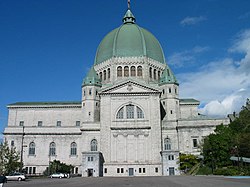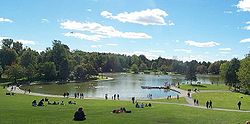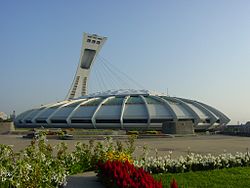Landmarks of Montreal
This articlecontains content that is written likean advertisement.(April 2024) |
Churches and other religious buildings
[edit]
Nicknamed "la ville aux cent clochers" (the city of a hundred belltowers), Montreal is renowned for its churches. As described byMark Twain,"This is the first time I was ever in a city where you couldn't throw a brick without breaking a church window." The city has fourRoman Catholicbasilicas:Mary, Queen of the World Cathedral,the aforementionedNotre-Dame Basilica,St. Patrick's Basilica,andSaint Joseph's Oratory. The Oratory is the largest church in Canada, with the largest dome of its kind in the world after that ofSaint Peter's BasilicainRome.
Other well-known churches include the pilgrimage church ofNotre-Dame-du-Bon-Secours,which is sometimes called the Sailors' Church, theChurch of St. Michael and St. Anthony,known for itsByzantine architecture,and theAnglicanChrist Church Cathedral,which was completely excavated and suspended in mid-air during the construction of part of the Underground City.
An impressive number of other churches, synagogues and mosques can be found, and church steeples are a familiar view all over the city and island.
Green Spaces in Montreal
[edit]The city’s public green spaces are categorized as major urban parks, neighborhood parks, city squares, and nature parks.[1]Parks offer recreational, educational, historical, and cultural programming aimed at engaging Montrealers in the outdoors, nature, and fitness.[2]Park activities vary seasonally, and each park features its own unique programming.[2]The city’s large parks account for approximately 2,000 hectares of the island’s land.[3]The Ville de Montreal also considers cemeteries, certain golf courses, and green alleys as green spaces.[4]Green spaces improve air quality, reduce the effect of urban heat islands, contribute to residents’ quality of life, preserve biodiversity, and improve the city’s aesthetic.[5]The city is also home to small scale neighborhood green spaces, such as green alleys and community gardens.
Below is a list of Montreal’s public green spaces:[1]
Major urban parks
[edit]Mount Royal
[edit]Mount Royal was designed in 1876 byFrederick Law Olmsted,best known as the designer ofNew York'sCentral Park.Mount Royal's features include the Chalet and the Kondiaronk Belvedere overlooking downtown Montreal, and man-made Beaver Lake (Lac aux Castors) with its recently renovated pavilion. Mount Royal is topped by an illuminated cross that has become a Montreal landmark.

Observant hikers on the park's many trails will find an abundance of small wildlife. In the winter, the park is the site of numerous cross-country ski trails and a new, refrigerated skating rink near Beaver Lake.

Once, afunicular railroadbrought sightseers to its peak, but it has long since disappeared.[1]Atramwayalso went up the mountain on the north side, replaced in the late 1950s by theCamillien HoudeParkway, which now bisects the mountain. The "11-Montagne" bus line now replaces the tram. Every Sunday in the summer, hundreds of people gather at theGeorge-Étienne Cartier Monument,at the foot ofMount Royal,for drumming, dancing, and juggling (among many other activities) in an event known as theTam-Tams.It is unclear how this event started; but, as it has no formal organization and has carried on both in a lively and peaceful way since at least the late 1980s. The intersection of Avenue du Parc and Avenue des Pins, just to the south, formerly a winding urban interchange (inspired by the New York parkways ofRobert Moses), underwent a major transformation to become more pedestrian-friendly.
Parc Jean-Drapeau
Located in the middle of theSt. Lawrence River,Parc Jean-Drapeau consists of the islands of Sainte-Hélène and Notre-Dame, which hostedExpo 67.Parc Jean-Drapeau is accessible bymétro,car, bicycle or boat. The islands are a popular destination for Montrealers due to their green spaces and sports and cultural activities.

Île Notre-Dame
[edit]The Floralies gardens are located at the centre of the island. Île Notre-Dame also has a network of canals, and, further west at the lake, offers a beach and other water sports. TheCasino de Montréaland ayouth hostelare also located here. The MontrealGrand Prixtakes place on the island at theCircuit Gilles Villeneuve,which in winter is used as a skating rink.
Île Sainte-Hélène
[edit]Built in 1814, the Fort on Saint Helen's Island houses theStewart Museum,dedicated to the history ofNew France.The island also contains several large public works of art, such as the imposing "Man", sculpted in steel by artistAlexander Calder.It is home to theBiosphère,Jean-Doré beach andSix FlagsLa Ronde.Buses run every 15 minutes from theJean-Drapeau metro stationtoLa Ronde.
History
[edit]Montreal’s driving force behind the creation of green spaces was inspired by the “City Beautiful” movement of the nineteenth century.[6]This led for many parks to be underway for development, producing green spaces that held a mix of picturesque, English-style gardens and the North American “City Beautiful” movement trend.[6]By the second half of the nineteenth century, Montreal completed building Parc La Fontaine, Parc Jean Drapeau and Parc du Mont-Royal which filled the city spaces, overall attracting more tourists to the area.[6]As many parks and green spaces were constructed in Montreal, it became evident that the Western parts of the island had more parks in comparison to the Eastern areas, which suffer lower socioeconomic status.[7]For example,Westmountis a wealthy anglophone neighbourhood with 12 parks and 22 green spaces.[8]In comparison, areas such asLaSalleand East of Montreal were identified as having less green spaces and higher vulnerabilities.[9]Beautifying Montreal through the construction of green spaces was seen as a symbol of economic progress and financial health.[10]Those who built the parks believed that the improvement in the appearance of the city would create social order along with the moral betterment of urban dwellers.[10]However, as the city grew in both size and in population, Montrealers began to lose interest in protecting their parks until 1970, when the Montreal Urban Community (MUC) was formed and park conservation options were considered.[11]This led to the MUC to invest over $100 million on creating additional green spaces, which resulted in more than 600 hectares of new parks.[12]Today, the city is known for spending the most on construction and design of green spaces in comparison to all other Canadian cities.[13]
Issues and controversies
[edit]Green spaces in Montreal have also been a place of conflict. In a series of policy decisions called the “Morality Cuts”, which targeted the LGBTQ2S+ community in the 1950s, Montreal mayor Jean Drapeau famously ordered for hundreds of trees in Mont Royal park to be cut down to deter gay cruising activity.[14][15]The clear cutting not only changed the look of the landscape but also introduced invasive species to the area, which continue to disturb the ecology of Mont Royal park today.[14]However, issues surrounding green space in Montreal do not only exist in the past, and controversy continues to this day. Urbanization on the island of Montreal has been detrimental to the protection and upkeep of green space.[11]The expansion of road networks throughout the early 2000s, specifically Autoroute 440, affected at least five separate green parks in the Île Bizard region.[11]
Green spaces that exist today are also not evenly distributed across the Montreal landscape.[16]There is a concentration of green spaces in the middle of the island –near the downtown core and surrounding neighbourhoods– but there exists a clear lack of parks available to the residents of the Eastern region of Montreal.[16]There have also been past issues with securing municipal and provincial funding to buy and protect green spaces on the island of Montreal.[11]In the 2002 budget year, the government set aside only $1.5 million dollars over three years for acquiring new green spaces and protecting existing parks in the city.[11]While there have been more recent investments in green spaces and talks of buying land on the West Island to make a large park, some of the area is privately owned and cannot be fully protected.[13]
Future developments
[edit]The future of green spaces in Montreal appears to be promising, but there are issues that showcase conflicts in the city’s future initiatives. The creation of a 3,000-hectare park in the northwest corner of Montreal, le Grand Parc de l’Ouest, is the city’s largest green space development, and will incorporate five nature reserves that will be connected through forests, wetlands, and trails.[17]Despite the praise it has received from environmentalists, it has also been criticized for its location in the higher-income west side, where parks are easily accessible to its residents.[18]The city has adopted the Protection and Enhancement of Natural Space, an ongoing policy since 2004, that will address the disparity in green space availability between east and west by focusing on parks such as the Saint Jacques Escarpment and the East Island Greenbelt.[19]Plans for the future of the Saint Jacques Escarpment belong to the larger Turcot Yards project.[20]In shifting the highway north, the city freed up space for a 2 km long park with a bicycle path, as well as green walkways to connect Notre Dame de Grace with other neighbourhoods that were inaccessible before.[20]Again, to promote accessibility, Montreal’s Mayor announced a budget of $18 million for shoreline redevelopment for 11 boroughs on both east and west ends.[21]This new project seeks to increase neighbourhood access to waterfront public spaces, by constructing new piers, expanding shorelines, and using these new areas to create green spaces.[21]The Mayor also announced the revitalization of the east-end’s Parc La Fontaine, by transforming the current road that divides the park into a pedestrian walkway, renovating the park’s theatre, and cleaning up its pond.[20]Although Montreal suffers from an east-west disparity in green spaces, it is demonstrating its commitment in diminishing this gap through the initiatives it has planned for the new decade.
Museums and cultural centres
[edit]
Montreal is the centre ofQuebec cultureand a major centre ofCanadian culturein general. It has many specialized museums such as theMontreal Museum of Fine Arts(MMFA), the Musée d'art contemporain (MAC), theRedpath Museum,theStewart Museum,theMcCord Museum of Canadian History,and theCanadian Centre for Architecture.ThePlace des Artscultural complex houses the MAC and several theatres, and is the seat of the Montreal Opera and theMontreal Symphony Orchestra,although the latter is slated to receive a new concert hall adjacent to Place des Arts.
Olympic Park
[edit]
The Olympic installations site is next toMetro Pie-IXandMetro Viau,6 km (3.7 mi) from downtown in theHochelaga-Maisonneuvedistrict, and consists of several buildings designed by French architectRoger Taillibert.TheOlympic Stadiumis ovoid shaped with a distinctive 'ribbed' look, and has the world's tallest inclined tower at 175 m (574 ft) high; it leans at 45 degrees. The complex includes theMontreal Biodome,originally a fully functionalvelodrome.Two pyramidal towers, known as the Olympic Village, were built to house athletes but now serve as both apartments and offices.
The Montreal1976 Summer Olympicswere successful, but construction problems and corruption created a massive financial burden for citizens. At the opening, the tower and the retractable roof were incomplete. The tower was completed years later but the retractable roof was never completed as originally planned byTaillibert.Anglo locals refer to the stadium as the "Big O" due to its shape, but also as the "Big Owe" — a reference to the Olympic Park's exorbitant total cost, which was only paid off thirty years later with the help of a special tobacco tax.
The stadium was also home to theExposfrom 1977 until the team moved toWashington, D.C.after the 2004 season, and has sometimes been home for theMontreal Alouettes.Today, Montreal's Olympic Park hosts limited professional sports events and is mainly a tourist and cultural attraction.
Montreal hosted the 2006 1stWorld Outgamesholding the opening/closing ceremonies and many of the events at theOlympic Stadium.The event drew over 10,000 participants. Most were Gay athletes, but many participated in other cultural events such as ballroom dancing. Opening ceremonies brought international athletes, local politicians, and entertainers.[citation needed]
Space for Life
[edit]Space for Life(French:Espace pour la vie) is a museum district. It consists of five natural museums: theBiosphere,theBiodome,theRio Tinto Alcan Planetarium,theBotanical Gardenand theInsectarium.
The Biosphere is a museum dedicated to theenvironment,housed in the former United States pavilion constructed forExpo 67.It is located inParc Jean-Drapeau,onSaint Helen's Island.The Biodome, a former velodrome, is a facility located in the Olympic Park which allows visitors to walk through replicas of various ecosystems. The Montreal Botanical Garden, located in the borough ofRosemont–La Petite-Patrie,comprises 75 hectares (190 acres) of thematic gardens and greenhouses. It is one of the biggest botanical Gardens in the world, second only toRoyal Botanic Gardens, KewinEngland.The Montreal Insectarium is located within the Botanical Garden and features many insects of various species, both live and dead.
Underground City
[edit]Montreal'sUnderground City(French: La ville souterraine) is the set of underground city complexes in and around downtown. It is also known as the indoor city (ville intérieure), as not all of it is underground. With over 32 km (20 mi) of tunnels spread over an area of 12 km2(4.6 sq mi), the 60 residential and commercial complexes comprise 3.6 km2(1.39 sq mi) of floor space, including 80% of all office space and 35% of all commercial space in downtown Montreal. Services includeshopping malls,hotels,banks,offices,museums,universities,sevenmetrostations, two commuter train stations, abus terminaland theBell Centrehockeyarena. There are more than 120 exterior access points to the underground city. Some 500,000 people use the underground city every day, especially to escape thetrafficand/or Montreal's harsh winter.
See also
[edit]References
[edit]- ^ab"A guide to Montréal's parks and green spaces | Tourisme Montréal".mtl.org.2017-08-10.Retrieved2020-07-26.
- ^ab"Voir la programmation des parcs-nature"[Discover the Nature Parks] (in French). Ville de Montréal.Retrieved2020-07-26.
- ^"Cartes et autres plans des grands parcs"[Maps and other plans of large parks] (in French). Ville de Montréal.Retrieved2020-07-26.
- ^"Master Plan".Ville de Montréal.Retrieved2020-07-26.
- ^"Les milieux naturels"[Natural Environments]. Ville de Montréal.Retrieved2020-07-26.
- ^abcDajardins, Maude."Open-air Spaces: Montreal's Parks".McCord Museum.Retrieved2020-07-26.
- ^D'Alimonte, Michael."A Montreal Map Showing The Richest And Poorest Neighbourhoods In The City".mtlblog.Retrieved2020-07-26.
- ^"Parks and green spaces".City of Westmount.Retrieved2020-07-26.
- ^Westgate, Geneviève (2018)."Equity and Green Space in Montreal"(PDF).Samuel Centre for Social Connectedness.
- ^abDagenais, Michèle (2009)."The Urbanization of Nature: Water Networks and Green Spaces in Montreal"(PDF).In MacEachern, Alan; Turkel, William J. (eds.).Method and Meaning in Canadian Environmental History.Toronto: Nelson. pp. 214–233.Retrieved2020-07-26.
- ^abcdeOljemark, Sylvia."Montreal's Green Space Story: Past and Present"(PDF).pp. 11.2–11.27.
- ^Thibert, Joël (2015).Governing Urban Regions Through Collaboration.London: Routledge.doi:10.4324/9781315585628.ISBN9781317125471.
- ^ab"Montreal could be doing more to create green spaces, report finds".CBC News. 2019-06-15.Retrieved2020-07-26.
- ^ab"How 1950s moralizing is still impacting Mount Royal's trees".CBC News. 2018-01-21.Retrieved2020-07-26.
- ^Caron, Matthieu (Fall 2018 – Spring 2019)."Taming the Jungle in the City: Uprooting Trees, Bushes, and Disorder from Mount Royal Park".Urban History Review.47(1–2): 39–53.doi:10.7202/1064877ar.ISSN0703-0428.S2CID211649026.
- ^abReyes, Mario; Páez, Antonio; Morency, Catherine (May 2014)."Walking accessibility to urban parks by children: A case study of Montreal".Landscape and Urban Planning.125:38–47.doi:10.1016/j.landurbplan.2014.02.002.ISSN0169-2046.
- ^Sucar, Daniel (2019-08-09)."Grand parc de l'Ouest: Environmentalists applaud plans for urban park in West Island".Montreal Gazette.Retrieved2020-07-26.
- ^Suh, Claire (2019-09-25)."Montréal Has Plans for Canada's Largest Urban Park – Is It Enough?".Samuel Centre for Social Connectedness.Retrieved2020-07-26.
- ^"Draft policy respecting the protection and enhancement of the natural environment"(PDF).Ville de Montréal. March 2004.Retrieved2020-07-26.
- ^abc"Transformation of the Turcot Yards"(PDF).Ville de Montréal. August 2018.Retrieved2020-07-26.
- ^abRiga, Andy (2019-02-23)."Montreal sets aside $75 million to improve parks, shorelines".Montreal Gazette.Retrieved2020-07-26.
